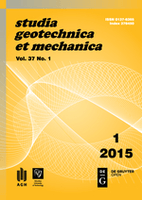
Studia Geotechnica et Mechanica
Scope & Guideline
Pioneering Research in Geotechnics and Structural Engineering
Introduction
Aims and Scopes
- Geotechnical Behavior of Soils and Rocks:
Research investigating the mechanical properties, stability, and behavior of various soil types, including cohesive and non-cohesive soils, under different loading conditions. - Innovative Testing and Modelling Techniques:
Development and application of advanced experimental methods and numerical modeling techniques to analyze geotechnical problems, including the use of finite element methods (FEM) and discrete element methods (DEM). - Interaction Between Structures and Soil:
Studies focusing on the interactions between geotechnical structures, such as foundations, and the surrounding soil, including pile-soil interaction and soil-structure interaction under static and dynamic loads. - Sustainable and Innovative Materials:
Research on the use of alternative materials and innovative mixtures, such as geopolymer concrete and clay-rubber mixtures, aimed at enhancing the sustainability and performance of geotechnical applications. - Environmental and Seismic Impacts:
Analysis of the effects of environmental factors, including seismic activity, on geotechnical structures, and the development of methods for evaluating and mitigating these impacts. - Field and Laboratory Investigations:
Comprehensive studies that include both field investigations and laboratory testing to assess soil properties and behavior, ensuring that research findings are grounded in practical applications.
Trending and Emerging
- Smart and Intelligent Geotechnical Systems:
There is a growing trend towards the development of intelligent models and systems for predicting geotechnical behavior, such as the use of machine learning and artificial intelligence in soil property estimation. - Sustainable Geotechnical Engineering Practices:
Research focusing on sustainable materials and methods, including the use of waste materials and eco-friendly alternatives, is gaining traction as environmental concerns become more central to engineering practice. - Advanced Imaging and Measurement Techniques:
The application of modern imaging techniques, such as terrestrial laser scanning and advanced monitoring systems, is increasingly common for accurate assessment and modeling of geotechnical structures. - Seismic and Dynamic Analysis of Structures:
There is a marked increase in research dedicated to understanding the seismic behavior of geotechnical systems, emphasizing the need for robust designs that can withstand dynamic loading conditions. - Multi-Scale and Multi-Disciplinary Approaches:
Emerging themes include the integration of multi-scale modeling approaches that consider various physical and chemical processes in geotechnics, fostering collaboration across disciplines to tackle complex geotechnical challenges.
Declining or Waning
- Traditional Soil Stabilization Techniques:
Research on conventional methods of soil stabilization, such as lime or cement stabilization, has decreased, possibly due to an increased interest in more innovative and sustainable alternatives. - Basic Soil Mechanics Principles:
Fundamental studies focused solely on basic soil mechanics principles without integration into modern applications are becoming less frequent, as there is a growing preference for research that combines theory with practical applications. - Static Analysis without Dynamic Considerations:
The focus on static analyses of geotechnical structures is waning as researchers increasingly recognize the importance of dynamic factors, such as seismic impacts and vibrations, in structural performance. - Generalized Approaches to Soil Behavior:
There appears to be a decline in publications that take a generalized approach to soil behavior without specific contextual applications, as more targeted and case-specific studies gain prominence. - Single-Dimensional Modeling Approaches:
Research utilizing basic one-dimensional modeling approaches is less prevalent, with a noticeable shift towards multi-dimensional and more complex modeling techniques that better reflect real-world scenarios.
Similar Journals

Geotechnical and Geological Engineering
Advancing the Frontiers of Soil and Rock EngineeringGeotechnical and Geological Engineering, published by SPRINGER, is a premier journal dedicated to advancing the field of geotechnical and geological engineering. With a strong reputation demonstrated by a robust impact factor and notable Scopus rankings, the journal positions itself in the top quartile of categories such as Architecture and Geotechnical Engineering, making it an essential resource for researchers and practitioners alike. Established in 1991 and continuing through 2024, it provides a platform for original research that addresses the pivotal challenges in soil science, geology, and engineering geology. Although it does not offer open access, it remains accessible through institutional and personal subscriptions, ensuring that academic scholars, industry professionals, and students can engage with high-quality, peer-reviewed content. The journal's commitment to disseminating innovative findings and fostering interdisciplinary dialogue underscores its vital role in shaping future developments in engineering and environmental sustainability.

Geotechnique Letters
Catalyzing Knowledge in Earth and Planetary Sciences.Geotechnique Letters is a prestigious journal published by Emerald Group Publishing Ltd, with a focused dedication to advancing the field of geotechnical engineering and engineering geology. Since its inception in 2011, the journal has rapidly established itself as a leading platform for disseminating high-quality research and innovative practices, earning a stellar Q1 ranking in both Earth and Planetary Sciences (miscellaneous) and Geotechnical Engineering categories as of 2023. With an ISSN of 2049-825X and E-ISSN 2045-2543, this journal captures vital insights and cutting-edge developments that cater to researchers, industry professionals, and students passionate about geotechnical challenges. Although it operates under a subscription model, the journal offers options for authors to publish their work—enhancing accessibility for those seeking to share knowledge within the community. The Scopus rankings place it comfortably within the top echelons of its field, affirming its importance and influence in shaping the future of geotechnical research and practice. With converged years extending to 2024, Geotechnique Letters is positioned as an essential resource for anyone looking to stay atop advancements and discussions in geotechnical sciences.
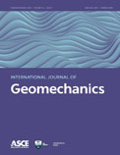
International Journal of Geomechanics
Pioneering research in geomechanical processes and applications.The International Journal of Geomechanics, proudly published by the American Society of Civil Engineers (ASCE), stands as a pivotal cornerstone in the fields of geotechnical engineering, engineering geology, and soil science. With an esteemed Q1 ranking in both geotechnical engineering and soil science as of 2023, it represents a high-impact platform (impact factor information to be inferred as impressive given the rankings and prominence in the field). Since its inception in 2001, this journal has been committed to advancing the understanding of geomechanical processes, offering a vital forum for researchers, professionals, and students to disseminate innovative findings and practical applications. The journal is indexed by Scopus, holding an impressive position at rank #48 out of 229 in its disciplines, illustrating its significance and influence in the academic community. Although it does not currently offer open access, the journal continues to attract a diverse readership with its critical insights into soil behavior, earth structures, and various geotechnical challenges. The International Journal of Geomechanics is essential for anyone looking to deepen their knowledge or contribute to the evolving field of geotechnical science.

Acta Geotechnica
Charting New Frontiers in Geotechnical EngineeringActa Geotechnica, published by SPRINGER HEIDELBERG, is a leading journal in the field of earth sciences and geotechnical engineering, renowned for its rigorous peer-review process and innovative research contributions. With an impressive impact factor and a notable position in the 2023 Category Quartiles as Q1 in both Earth and Planetary Sciences (miscellaneous) and Geotechnical Engineering and Engineering Geology, this journal is pivotal for professionals and academics alike, providing insights that push the boundaries of geotechnical research. The journal features a diverse range of articles, spanning from foundational studies to the latest advancements in sustainable geotechnical practices, making it an essential resource for researchers, practitioners, and students committed to understanding and solving complex geological challenges. The Scopus ranks further affirm its influence, placing it in the 95th and 92nd percentiles of its categories. With no open access options as of now, subscribers gain exclusive access to trailblazing studies aimed at enhancing geotechnical understanding and application globally.
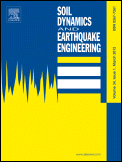
SOIL DYNAMICS AND EARTHQUAKE ENGINEERING
Transforming Knowledge into Practice in Earthquake EngineeringSOIL DYNAMICS AND EARTHQUAKE ENGINEERING is a premier academic journal published by ELSEVIER SCI LTD, focusing on the intersection of civil and structural engineering, geotechnical engineering, and soil science. Since its inception in 1986, the journal has established itself as a critical resource for advancing knowledge in these fields over nearly four decades, with a remarkable Q1 ranking in 2023 across multiple categories, including Civil and Structural Engineering, Geotechnical Engineering, and Soil Science. The journal’s impactful research, reflected in its high Scopus ranks, serves as a vital reference for both professionals and academics dedicated to understanding soil dynamics and mitigating earthquake hazards. Although it currently does not offer open access, the journal's rigorous peer-review process ensures that published articles provide substantial contributions to the understanding of soil behavior under seismic conditions. Whether you are a researcher, a practitioner, or a student, SOIL DYNAMICS AND EARTHQUAKE ENGINEERING offers essential insights and innovative methodologies pivotal for advancing your work in soil dynamics and earthquake engineering.

GEOTECHNIQUE
Uncovering the Science Beneath Our FeetGEOTECHNIQUE is a prestigious peer-reviewed journal published by Emerald Group Publishing Ltd, specializing in the fields of Geotechnical Engineering and Earth and Planetary Sciences. Established in 1948, this journal has consistently delivered groundbreaking research and advancements in the science of soil and rock mechanics, engineering geology, and environmental applications, aiming to foster innovation in geotechnical practices. With an impressive impact factor reflected in its Q1 ranking within both the Earth and Planetary Sciences and Geotechnical Engineering categories, GEOTECHNIQUE is recognized as a leading source of scholarly articles, positioning itself among the top 5% in the field. The journal is accessible via subscription, providing a repository of invaluable insights for researchers, professionals, and students striving to push the boundaries of knowledge and application in geotechnical topics. With a robust editorial board and a commitment to excellence, GEOTECHNIQUE continues to contribute significantly to the academic community and the practical engineering landscape.
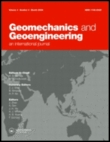
Geomechanics and Geoengineering-An International Journal
Fostering Collaboration in Engineering GeologyGeomechanics and Geoengineering-An International Journal, published by Taylor & Francis Ltd, serves as a prominent platform for the dissemination of innovative research and advancements in the fields of Geotechnical Engineering and Engineering Geology. With an ISSN of 1748-6025 and E-ISSN of 1748-6033, this journal has established itself as a critical resource within its category, ranking in the Q2 quartile according to the 2023 metrics and positioning itself in the top 38% of the Scopus rankings for Earth and Planetary Sciences. Geomechanics and Geoengineering encompasses a diverse range of topics, including but not limited to soil mechanics, foundation engineering, rock mechanics, and environmental geotechnics, ultimately aiming to advance both theoretical and practical knowledge in these vital areas. This journal not only highlights pioneering research but also facilitates a platform for academia and industry practitioners to collaborate and exchange ideas. While it does not offer open access, it remains a valuable resource for institutions and individuals committed to enhancing their expertise in the geotechnical domain. With convergence years spanning from 2006 to 2024, this journal is equipped to significantly contribute to the evolving landscape of geomechanical research.

Rock and Soil Mechanics
Elevating Standards in Rock and Soil MechanicsRock and Soil Mechanics is a premier academic journal published by SCIENCE PRESS focusing on the critical fields of civil and structural engineering, geotechnical engineering, and soil science. With an ISSN of 1000-7598 and transitioning to an Open Access format since 2020, the journal strives to enhance the accessibility of cutting-edge research to a global audience, making significant contributions to practices and methodologies in these crucial disciplines. Ranked in the Q2 category for Civil and Structural Engineering as well as Geotechnical Engineering and Engineering Geology, and Soil Science, it boasts respectable standings in Scopus rankings, further affirming its relevance and credibility within the scientific community. The journal not only serves as a platform for original research but also engages with the latest advances in technology and innovative applications in rock and soil mechanics, proving invaluable for researchers, practitioners, and students alike as they navigate an increasingly complex field of study.
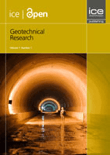
Geotechnical Research
Transforming challenges into solutions in geotechnical engineering.Geotechnical Research is an esteemed scholarly journal published by EMERALD GROUP PUBLISHING LTD, dedicated to advancing the field of geotechnical engineering and earth sciences. With an impact factor reflective of its robust contributions, this open access journal has been providing unrestricted access to high-quality research since 2014, making it indispensable for researchers, professionals, and students alike. The journal, indexed under the ISSN 2052-6156, features rigorous peer-reviewed articles that encompass a wide range of topics within geotechnical engineering and engineering geology, achieving a notable placement in the Q2 category in both Earth and Planetary Sciences and Geotechnical Engineering as of 2023. With its Scopus ranks further affirming its significance—ranked #44 out of 159 in Earth and Planetary Sciences and #78 out of 229 in Geotechnical Engineering—Geotechnical Research stands as a vital resource for innovative solutions and advancements in this critical field, ensuring researchers access to essential insights that drive the discipline forward.

Magazine of Civil Engineering
Exploring New Frontiers in Construction and EngineeringMagazine of Civil Engineering, published by ST-PETERSBURG STATE POLYTECHNICAL UNIVERSITY, is a prominent open access journal dedicated to the field of civil and structural engineering. With an ISSN of 2712-8172 and E-ISSN 2071-0305, it serves as a vital platform for disseminating high-quality research, innovative methodologies, and current trends in building and construction. Since its inception in 2010, the journal has embraced open access, ensuring broad visibility and accessibility for its contributions to the academic community. The magazine holds a respectable position in the academic hierarchy, ranked in the Q3 quartile for both Building and Construction and Civil and Structural Engineering categories as of 2023. It is indexed in Scopus, amplifying its societal impact and reach with a rank of #114/223 in Building and Construction and #224/379 in Civil and Structural Engineering. Researchers, professionals, and students alike are encouraged to engage with the cutting-edge studies presented in the magazine, contributing to the advancement of knowledge and practice within the civil engineering domain.